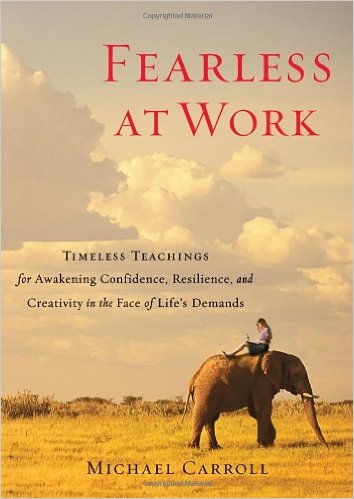
by Michael Carroll
Whether we are mildly anxious about an impending surgery or deeply distressed about losing our favorite pencil, sickened at the death of our child or utterly terrified by a raging war, fear is starkly intimate — woven into our lives, shaping how we choose to spend the few hours we live on this planet.
We can take various perspectives on fear. Anthropologists trace fear back millions of years to our days as small mammals bumbling beneath jungle shrubs and the feet of massive carnivores. Fear was our mechanism for sensing and reacting instinctively to dangers of all kinds. We would “fight”, “fly” or “freeze” when facing a threat and those of us who made the right choice lived another day.
Or we could explore fear from the view of a neurophysiologist, examining our brain and nervous system. When confronted with a visual conflict as simple as a misplaced symbol or an unknown sound, parts of our brain light up that focus our attention and signal a need to “problem solve”. Fear, for the neurophysiologists, is a stimulus to investigate, discern and resolve.
Or we could trace words to their origin — examining the etymology of coward, for example: from “cowherd” where animals were made to cower — to crouch in terror, where fainthearted beasts, tails between their legs, lower themselves, trading their nobleness for subservient safety.
Of course we are afraid of death and pain, afraid that we can’t handle life. We fear new situations and the unknown. Yet, while we may want to define fear, explore fear and possibly even resolve it, we first must acknowledge that we cannot actually find such a solid thing as “fear” at all. Like everything else in life, fear has no fixed point but is, instead, fluid, unpredictable and livelier than a “word” or scientific study. So in order to explore such a thing we will need to move with it, live it — “be” it so to speak. In order to recognize fear, then, we will need to examine our experience, right here right now. So let’s pause for a moment and take stock of our situation.
On the one hand, circumstances seem pretty obvious. We are Mary or Bob. We have a job and family and friends. We have an address and we have a bedroom and a kitchen. We have a “biography” — we went to certain schools, fell in love with various partners, we have pets and credit cards; coin collections and favorite movies. And right now we are sitting somewhere as a particular body that has all kinds of lively little features — some we enjoy, some that perturb us and many we take for granted.
On the other hand, when we examine this “biography” closer, what at first glance may appear to be obvious, becomes elusive. Mary or Bob — these are just words that our parents were kind enough to offer us at our birth. We are not Mary or Bob. We are not our names.
Schools and friends; pets and credit cards, while very real at the moment when we actually live our lives through them, now at this moment right here, right now — they are mere memories. And our body — vivid and visceral — seems to function with or without our permission — as much an unknown as a familiarity.
When we pause and take stock of our experience at its most fundamental level, who we are is more elusive than certain; more ungraspable than apparent. The background of our lives, when brought into foreground reveals a sharp all-pervading uncertainty. Nothing — our name, our “biography”, our history, friends and relations — nothing is as certain as it seems.
Normally, we don’t attend to this shapelessness. We go about our lives as Mary and Bob living our “biography”. But when the elusive uncertain nature of life shifts from background to foreground — as it always does — we struggle and panic. Falling in love with a colleague, being diagnosed with cancer or just missing an appointment, we instinctively sense that life happens in a way that we cannot grasp and we become bewildered.
Becoming familiar with such bewilderment is how we examine and recognize fear. Yet, this is not a matter of analysis or therapy however. We are not interested in explaining our reasons for being afraid or even resolving our anxiety. In this case, we want to see our fear directly — to touch it and recognize it — and we learn to do so by practicing mindfulness awareness meditation.
One of the fascinating challenges in meditation, especially in the beginning of getting to know the practice, is how uncomfortable we are with doing nothing. At some point we discover that we are panicking because we are not sure what is going on. Experiencing this type of panic is like being dazed, disoriented, and in a kind of fog. It’s like asking ourselves over and over again “What’s going on here? Am I going to be OK? Is this working out?”
In trying to get an answer to these questions and get a grasp on the uncertain circumstances, we breed cowardice with story lines of all kinds. “I’m freaked out because I am going to lose my job and won’t be able to handle life!” or “I’m worried because Sasha is going to fall in love with Gerald and leave me behind!” or “I think my foot has cancer — it hasn’t been behaving itself lately”.
Through the practice of mindfulness awareness meditation we learn that we need not perpetuate panic and breed cowardice with all kinds of stories, but instead we can experience the shapeless uncertainty without anything to hold onto. Placing our attention on our breath, we go out and gap — we are sitting in space, afraid, with no answers. We let go of our story lines and logics and leap into the uncertainty — completely groundless. We join our fear with the total uncertainty of it all.
By having the courage to recognize fear and embrace the shapeless uncertainty of our experience over and over again — literally thousands of times on and off the cushion — the fog of our bewilderment gradually lifts and we discover a most perplexing and delightful irony: the uncertainty that has been bewildering us is, in fact, the very freedom that we have been looking for. And by leaping in with no guarantees, we stop seeking a life free from fear, but instead discover how to live life fearlessly.
Michael Carroll is an AMT Affiliated Instructor and serves on the Board of Directors. This post is adapted from his book Fearless at Work: Timeless Teachings for Awakening Confidence, Resilience, and Creativity in the Face of Life’s Demands. Learn more about Michael, his work, and his other books on mindfulness on his website: http://awakeatwork.net

